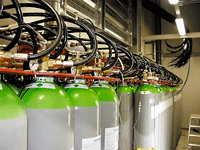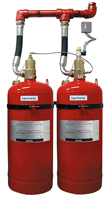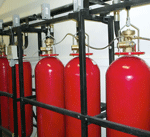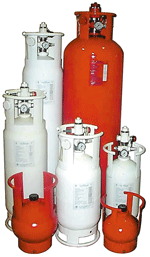#gas fire extinguishing
Gas fire extinguishing systems.
Since the middle of the last century, the designs of gas fire extinguishing modules have undoubtedly improved significantly.
However, the demand for updated modules and their prototypes is the same today.
How to avoid purchasing outdated models, what criteria to use to make the right choice?
Gas fire extinguishing systems are used to protect the most important and valuable objects, since fire extinguishing gases do not cause damage to the protected object and materials, are non-conductive, and quickly and easily spread throughout the entire space of the room, providing volumetric extinguishing even in the most inaccessible areas.
After extinguishing, gases are eliminated by simple ventilation or using portable smoke exhaust fans. In gas extinguishing systems, gases are stored in special gas fire extinguishing modules, which are a cylinder equipped with a shut-off and starting device (ZPU).
Disadvantages of obsolete designs
The designs of the first modules for automatic gas fire extinguishing systems appeared in the middle of the last century and consisted of a 40-liter cylinder [according to GOST 949], made of a carbon steel pipe, and a shut-off and starting device of the GZSM or GAVZ type.
The nominal bore diameter of these ZPUs was only 10–12 mm, the duration of the release of fire extinguishing gas was allowed by the standards of that time to be up to 2 minutes.
As experience in operating gas installations accumulated, the shortcomings of their design became increasingly obvious.
Thus, the low tightness of shut-off and starting devices of the GZSM and GAVZ types gradually turned into a problem of monitoring the safety of fire extinguishing gas.
The probability of losing the required minimum gas in fire extinguishing installations required periodic (once per quarter) weighing of modules – a very labor-intensive operation, which included dismantling heavy modules, weighing them on scales and re-assembling them.
As a result, threaded connections and sealing elements wore out. Modules often failed to operate due to the low reliability of PP-3 (PP-7) pyropatrons.
A significant operational disadvantage of these modules also included a fairly short (only 5 years) period of their technical inspection.
Decades have been spent discussing the need to replace obsolete modules with other, more advanced ones. In the early 1990s, market relations and new regulatory requirements initiated an intensive process of developing new products.
Currently, we can note the filling of the domestic market with modern modules with a capacity of 8 to 160 liters, which are equipped with ZPUs of various designs.
At the same time, it is surprising that consumers still demand modules of outdated designs with a low technical level.
Obviously, this can only be explained by the consumer's insufficient awareness or his inability to competently assess the technical level of the offered products.
There is a paradoxical situation in which the consumer, without going deeply into technical details, pays the same price both for modules with the maximum set of consumer qualities and for modules whose consumer properties are significantly worse.
A way out of this situation could be the introduction of a mandatory rule for design organizations to justify the choice of gas fire extinguishing equipment and the corresponding fire extinguishing gas based on a technical and economic comparison of different options.
This problem can also be solved by holding tenders, however, when developing tender documentation, it is necessary to take into account not only capital costs for the acquisition of equipment and its installation, but also current costs associated with subsequent operation.
The most effective solution can be made by assessing all cost items.
Technical requirements
The most general technical requirements for modules are set out in fire safety standards NPB-54 (currently NPB-54 from 2001 is in effect, replacing the outdated ones from 1966).
The new version of the standards contains changes to a number of requirements. In particular, the requirements for the tightness of modules have been significantly increased.
If previously a leak of fire extinguishing gas of no more than 5% by weight and no more than 10% by pressure was allowed per year, then the new standards limit the leak of GFTS per year by weight and pressure to no more than 1% and 2%, respectively.
The requirements for paragraph 3.3.1 (NPB54-96), which regulated the delivery set, have changed.
In accordance with the new version of NPB 54-2001 (clause 3.6.1), it is not required to include in the spare parts kit devices and spare parts that ensure at least 2 module activations.
Thus, the norm that put manufacturers of modules with a pyrotechnic start in an unequal position with other manufacturers using an electromagnetic drive has been eliminated.
The current version of the NPB includes increased requirements for module reliability. Thus, the probability of failure-free operation equal to 0.95 is set for all modules with a maintenance frequency of at least once every 3 years.
In the old version, in order to maintain the operability of the module at the same level of failure-free operation probability, a minimum maintenance period of 1 year was set.
It should be noted that NPB-54 in their current version establish the lowest level of the most general technical requirements imposed on modules.
As a result, after testing according to NPB-54, the manufacturers of modules that differ significantly in their technical level and technical capabilities become holders of fire safety certificates.
In other words, the presence of a fire safety certificate is evidence of the minimum technical level of the product.
New gas fire extinguishing modules are modern, convenient, reliable
The high-pressure cylinder occupies an important place in the design of the module.
The main criterion for its evaluation is the coefficient of weight return, which characterizes its metal content and technological level of manufacture. The higher the value of this coefficient, the more perfect is the design of the vessel.
Almost all cylinders are manufactured using outdated traditional technology. The cylinder is heavy, thick-walled, with a wall that is not uniform in strength properties, in which there are cavities, cracks and other defects.
The problems of corrosion compensation during operation and ensuring strength properties with this technology are solved only by additionally increasing the thickness of the cylinder wall. As some experts explain, the more massive the cylinder, the thicker its wall, the stronger and more impact-resistant it is.
However, this is not so, and its massiveness is rather a disadvantage and a sign of backward technology than a valuable consumer quality.
For the production of modern light high-pressure cylinders, high-strength alloy steel of high homogeneity of class AKS (atmospheric, corrosion-resistant) is used, which has a higher (2-3 times) corrosion resistance and increased adhesive properties to paint and varnish coatings in comparison with other steels.
The presence of an internal coating in the form of a phosphating primer and highly elastic VK glue provides additional protection of the cylinder from the effects of aggressive environments and increases corrosion resistance by another 1.5–2 times.
Rust does not form either inside or outside the cylinders.
Due to this property, a fifteen-year service life is established for such modules before the first technical inspection. The estimated service life of the cylinders is at least 30 years and can be increased based on the results of operation.
The module's shut-off and starting device usually contains three main units: a shut-off element, a starting element, and a drive.
In domestic and foreign practice, two types of shut-off elements are used: valve and membrane. The former have a detachable “valve-seat” section.
When triggered, the valve moves away from the seat, releasing the outlet.
Membrane units do not contain a movable detachable section; they open by destroying the shut-off element.
Due to the presence of a large diameter split section in the valve unit, it is fundamentally less hermetic than a membrane unit.
Under conditions of increased vibration and shock loading, the hermeticity of the valve unit is further impaired.
The ZPU drive, as a rule, contains kinematic mechanisms: pistons, valves, levers on axles and other moving elements that must be rotated or moved to ensure operation. The starting element of the ZPU is usually electromagnets or pyropatrons.
The latter are the most widely used, as they do not contain moving elements (all energy is concentrated in their charge) and do not require maintenance.
At a facility equipped with a gas fire extinguishing system, modules can be in standby mode without triggering for a very long period (10 years or more).
Under these conditions, the module's ZPU is immobilized, it is subject to aging, corrosion, contamination, and souring.
The module must ensure not only long-term storage without loss of fire extinguishing gas, but also trouble-free start-up at the end of its service life, when the object has “aged” along with the module and the probability of fire has increased.
Moving starter and drive mechanisms, shut-off valves, which have never been moved during a long period of operation, may lose their ability to operate if they are not cleaned and trained.
Foreign standards require solenoid training at least once every three months.
Currently, Russia has developed devices in which the shut-off element is made in the form of a rupture element, which is a gas-tight and non-detachable jumper.
The drive in the ZPU is not required — the design is two-link (shut-off element — starting element).
A special pyropatron is used as a starting element, the pyropatron charge of which is hermetically separated from the environment by a stainless steel housing, guaranteed to maintain operability with a probability of 0.999 for 17 years.
To increase reliability, the pyropatron has two galvanically isolated spirals.
To activate it, a low-power starting pulse is required compared to an electromagnet, which is generated by almost any control device.
Gas fire extinguishing modules MPG (NPO «Fire Automatics Service»)
Gas fire extinguishing modules MPG are designed for long-term storage and release of gas fire extinguishing agents (GOTV).
All permitted GOTV can be used in the modules. The modules are used to extinguish class A, B and C fires and electrical equipment under voltage.
The modules are used to build modular and centralized installations.
The module consists of a cylinder and a shut-off and starting device (SSD).
The modules are manufactured in several versions and differ in the following parameters.
Working pressure: high pressure (150 bar), low pressure (60 bar).
Cylinder capacity: from 6 to 160 l.
SSD diameters: 24 mm, 40 mm.
Types of ZPU: with a burst valve (with a start from the pyrotechnic starting device PUO-2); with a valve valve and a starting membrane (with a start from an electromagnet, pyrotechnic pusher PT-2 and pneumatic start); with a valve valve and a servo valve (with a start from an electromagnet, pyrotechnic pusher PT-12 and pneumatic start).
Types of cylinders: BK-6601-400 TU cylinder with a capacity of 6 to 100 l; GOST 949 cylinder with a capacity from 20 to 50 liters.

Gas fire extinguishing module MPG with a valve shutter and servo valve (NPO «Fire Automatics Service»)
Innovative development — gas fire extinguishing module MPG with a valve shutter and servo valve, designed for long-term storage under pressure and release of gas fire extinguishing agents (GOTV).
The product innovation relates mainly to the design of the ZPU.
A design of a multiple-action ZPU has been created without the use of disposable elements and the need to disassemble the ZPU after activation to restore operability.
After the module has been activated, the ZPU valve shutter automatically returns to its original operating position.
The ability to combine various methods of actuating the module in a single starting unit has been ensured.
The module's starting unit is unified in such a way that it provides the ability to use various methods of actuation: electric, pneumatic and manual, both individually and in any combination.
This advantage is especially evident when modules are operating in a common assembly (battery), when it is necessary to ensure the release of GFFS from modules in groups of different numbers.
It is possible to check the ZPU for operation during operation without releasing GFFS from the module.
The module, when using additionally installed elements and devices, can ensure the preservation of the GFFS in the module in the event of an emergency destruction of the safety membrane, the ability to replace the safety membrane in the event of its destruction or expiration of the shelf life without releasing the GFFS from the module, automatic monitoring of the boost pressure in the module and the mass of the GFFS in the module during operation.

INERGEN (TYCO)
Fire extinguishing systems using the INERGEN gas composition allow us to successfully cope with the solution of three main tasks facing designers of modern fire extinguishing systems:
— protection of life
— protection of property
— protection of the environment
The use of gas fire extinguishing systems using INERGEN gas is the optimal solution for fire protection of sensitive electronic equipment, cultural and historical values, as well as property that cannot be restored in case of damage.
INERGEN contains only natural gases:
Nitrogen — 52%
Argon — 40%
Carbon dioxide — 8%
Inergen is absolutely harmless to the environment:
— does not affect the reduction of the ozone layer of the earth;
— does not contribute to general global warming;
— does not linger in the atmosphere
Application: server rooms, base units, hospitals, archives and museums, command centers, etc.
Gas fire extinguishing modules (batteries) MPDU 150-100-12 (B2-B10 MPDU 150-100-12), GOTV — CO2 (MGP Spetsavtomatika)
Gas fire extinguishing modules MPDU 150-100-12 and gas fire extinguishing batteries type B2-B10 MPDU 150-100-12 are used for fire protection of premises and process equipment as part of modular and centralized gas fire extinguishing installations.

The modules are inexpensive and easy to maintain and install, provide constant monitoring of the gas mass and remote monitoring of the module status.
The electronic mass control device (EMD) is built directly into the module's shut-off and starting device (SSD). The EMD is connected to an external power source via a standard connecting plug.
All information (contents of the GFTS, temperature, calibration date, service date) is stored in the UKM storage device and transmitted to the computer via the RS232 or USB port.
For visual control, the module's ZPU is equipped with an LED that signals normal operation, a decrease in the GFTS mass by 5% or more, or a UKM malfunction.
Two methods of starting batteries are used:
— using a special starting cylinder with nitrogen, which starts the battery pneumatically.
The starting cylinder start type is an electromagnet or a pyropatron.
— using a starting module with a fire extinguishing agent, which starts the battery pneumatically.
The starting module start type is an electromagnet or a pyropatron.
Novec™ 1230 fire extinguishing agent (Pozhtekhnika)
Fire extinguishing systems using Novec™ 1230 extinguishing agent are designed to extinguish combustible materials, flammable liquids, gases and electrical equipment.
Due to the chemical structure of Novec™ 1230, a minimum concentration of 4.2% is required for reliable extinguishing.

The extinguishing principle is based on the cooling effect.
In the area of the fire source, each molecule of the extinguishing agent instantly disintegrates, increasing the volume of extinguishing gas by 19 times!
The breakdown of molecules is accompanied by the absorption of thermal energy released during combustion, without reducing the level of oxygen necessary for life.
This leads to a decrease in temperature in the fire area, which prevents re-ignition. Novec™ 1230 is safe for humans and the environment.
LPG gas fire extinguishing equipment (Spain)
The equipment is certified for an operating pressure of 160 atm (test pressure 250 atm), which meets European safety standards and allows for higher filling factors for all types of freons.
The modules and batteries are started by actuating a solenoid valve, which is a more progressive and reliable method compared to starting from a pyropatron.

A wide range of cylinder capacities (5.1 l, 13.4 l, 26.8 l, 40 l, 67 l, 75 l, 100 l and 120 l) allows for the optimal construction of a gas fire extinguishing system.
LPG equipment is operated and stored at a wide range of temperatures from -40 to + 60 degrees C.
Weighing devices provide control of the gas mass in each cylinder and issue a signal when the mass decreases by more than 5%.
One panel controls up to 32 cylinders.
